 ?Mathematical formulae have been encoded as MathML and are displayed in this HTML version using MathJax in order to improve their display. Uncheck the box to turn MathJax off. This feature requires Javascript. Click on a formula to zoom.
?Mathematical formulae have been encoded as MathML and are displayed in this HTML version using MathJax in order to improve their display. Uncheck the box to turn MathJax off. This feature requires Javascript. Click on a formula to zoom.Abstract
Unpaved roads can be affected by high traffic demand and environmental conditions, decreasing its serviceability. To improve mechanical performance and reduce maintenance costs in soils, chemical stabilization techniques have been widely used and it is additive selection depends mainly on the available soil. In this research, an experimental study for different soil-additive combinations was conducted and analyzed, considering several soils based in andesitic rocks, for analyzing soil strength improvement after chemical stabilization. The results showed a dependency regarding the grain size distribution of the soil, but also on the plasticity index and the moisture content of the sample, which differs significantly from some literature guidelines. Proper conditions of soil characteristics and water-additive concentration may lead up to an increase of twice the initial soil strength. The concentration of additive per unit volume of wet soil leads to define an Effective Additive Concentration (EAC) parameter, that provides an optimal increase of soil shear strength. It is proven that exists a clear tendency of optimal EAC value for asphalt or polymeric additives, as well as some tendencies for enzymatic additives that need to be further developed, due to its dependence on the chemical composition of the soils.
PUBLIC INTEREST STATEMENT
Rural roads are still widely used around the world, and as often the conditions of the ground do not have enough strength or proper serviceability, the application of additives is necessary to improve its performance. As the result depends on the combination between soil type and additive, in this research, several soil-additive combinations were studied, based on soils from andesitic rocks. It was possible to determine the ranges of expected improvement, and consequently, the optimum conditions of moisture or concentration of the additive. The main conclusion is the proposal of a standard parameter of effective concentration, which gathers the best combination of moisture and additive per volume of soil. This study embarks on research and collaboration with industry, to progressively obtain the biggest improvement for rural roads and lower costs associated.
1. Introduction
Non-pavemented roads are widely used for temporary purposes such as mining industry access, as well as permanent roads outside big cities areas, reaching considerable amounts of total constructed roads (Obras Publicas, Citation2018). As these roads may have heavy traffic demand, maintaining the conditions of performance and serviceability are important to the overall behavior of roads and many soils with its in-situ conditions are not suitable to carry loads without high cost of maintenance in long-term. For improving mechanical behavior, stabilization methods may be applied to in-situ soils through a blend of water and chemical additive, also known as chemical stabilization method, in order to improve bearing capacity or decreasing permeability (or both) and reducing maintenance costs over time. Shear strength increase due to the soil-stabilizer interaction is highly dependent on the characteristics of the original soil and the concentration of the chemical blend application. Hence, every combination of these parameters may result in a different performance of the stabilized road, for example, depending severely on the project location (Parsons & Milburn, Citation2003).
Soil improvement with chemical stabilization depends on the micro-level interaction between moisture and fine content of soils (Sharma, Swain, & Sahoo, Citation2012), and consequently, the effect on mechanical behavior depends on the mineralogical composition of soils and its plasticity index (Naeini & Ziaie, Citation2009). Because of in-situ soil conditions are harder to be controlled, usually, the improvement through a soil-additive method has been given empirically by the selection of the additive, after a general characterization of the soil.
The most popular additives for increasing bearing capacity, such as concrete, asphalt, polymeric, enzymatic or bituminous emulsions, has been extensively reviewed (Afrin, Citation2017; Sherwood, Citation1993) and summarized lately. Those studies have concluded in some applications guidelines (Jones, Rahin, Saadeh, & Harvey, Citation2010; National Academies of Sciences, Citation2009), or normative such as provided by governmental entities (Army, Citation1997) or standards as NCh2505 in Chile (NCh2505, NCh2505, Citation2001). Summarizing some of their conclusions, authors agrees on the efficiency of some specific chemical additives for specific soils depending on soil composition or plasticity, for example, a selection for soil-cement for granular and cohesive soils tend to show good results (Peter & Little, Citation2002), but not necessarily an additive provides an strength improvement effect for all cases because of the influence of fines content (Zhao, Gao, Zhang, & Wang, Citation2016). Besides, the efficiency of the additive-soil interaction also depends on its concentration per unit soil volume, thus a low quantity of water-additive will not interact with enough soil and a bigger amount of additive volume may decrease their bearing capacity improvement. Hence, it exists an optimal ratio for stabilization. and further applications are suitable to be studied in the future (Tingle & Santori, Citation2003).
As soil strength behavior depends on the soil characteristics and the water-additive selection, it is necessary to have a specific technical framework before choosing. Due to its characteristics and its extensive presence worldwide, this study is focused on andesite formed soils. Andesitic based soil consists in an ash volcanic origin, with a fine fraction that may behave like high or low plasticity mud, and in some particular cases, moisture changes in clay derived from andesite rocks may present expansive behavior (Verdugo, Citation2008). In order to provide a framework for these soil-additive combinations, in this research a complete set of experimental results of applying different chemical stabilizer to different soils is presented, varying their strength in terms of water-additive concentration, fines content, and plasticity index. Then, results are compared to the non-stabilized condition and some key aspects of choosing additive are presented and a new parameter is proposed to consider an unique and optimal concentration regarding the moisture content and the soil volume. Finally, comments on recommended guidelines for choosing soil-additive combination were analyzed.
2. Methodology
For analyzing soil-additive behavior and potential increasing on mechanical strength, laboratory tests for non-stabilized soils and stabilized soils with different additives were conducted. Laboratory datasets were obtained according to non-pavement roads usual soil characterization using the optimal moisture content obtained with Proctor tests, to further obtain mechanical characterization with California Bearing Ratio (CBR) tests and Unconfined Compressive Strength (UCS) tests. Just few studies with other tests, such as conventional triaxial testing, are available in literature (Amin, Citation2015).
To describe soil behavior before the additive application, three main characteristics were described as follows:
Soil characterization: granulometric curve to determine fine content and plasticity behavior in terms of moisture content with Atterberg limits.
Soil state: moisture content, dry unit weight, and design unit weight for using additive with Modified Proctor test.
Strength properties: shear stress failure condition for non-stabilized soil. Obtained with California Bearing Ratio and Unconfined Compressive Strength test.
After the application of the chemical stabilization method, the chemical stabilizer reacts with the available water content within the sample, that tends to be heterogeneous, grouping the particles. This process leads to an improvement in shear strength by adding a cohesive strength component to the soil-mix initial condition, and to an increase in stiffness, as shown in Figure . This reaction helps to create stress-chains from the road surface to the basal ground and reduce the volume of water and additive necessary to obtain a shear strength improvement. As strength shear improvement with chemical stabilization depends on individual reactions for a specific combination of soil-additive, soil properties such as plasticity or fine content (FC), also influence the water-additive concentration required for the in-situ soil sample.
Figure 1. Moisture content distribution inside an unpaved road, considering the application of a chemical stabilization method. Stress-chains are developed within the improved soil
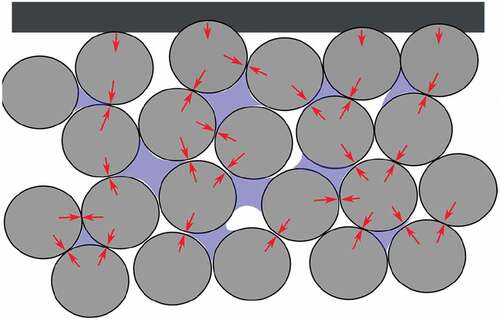
Then, shear strength improvement may be defined as the sum of the specific effects of an additive to a specific type of soil, and it can be written as:
where:
: Soil strength improvement for a chemical stabilizer additive k applied to a specific type of soil i.
: Soil mass percentage for a specific particle diameter or soil i. Maybe grouped such as gravel, sand or fine particles.
: Soil strength without chemical stabilizer for a certain soil i
In order to obtain a more specific parameter for water-additive concentration for a certain volume of soil sample, a volumetric concentration of the additive may be defined in terms of an Effective Additive Concentration (EAC), for taking into account the real quantity of additive in a specific volume of soil. The formula for the EAC parameter is expressed as:
where
: Water-additive Concentration to be applied for a certain sample i.
: Moisture content assessed in sample i.
Finally, in order to compare soil strength of initial condition and after the application of chemical stabilization, a relative error parameter is applied for a specific combination of soil and additive, according to EquationEquation (3)(3)
(3) , as
where:
: Assessed strength improvement in a soil i after adding chemical stabilizer k.
: Nominal value for shear strength of a soil i at the original condition.
2.1. Initial experimental dataset
An initial set of six different soils characterizations were tested and analyzed through 11 samples to characterize shear strength, considering a soil optimal compacted condition without chemical stabilization, using Unconfined Compressive Strength and CBR tests, as presented in Figure (a,b) respectively. All UCS samples were tested using an aspect ratio of 2.0. Results for non-chemically stabilized soils are summarized in Table .
Table 1. Summary of characterization and laboratory results for all studied soils, before the application of the chemical stabilization method
Figure 2. Examples of chemically stabilized soil testing during this research, for any type of soil-stabilizer combination. In (a) Soil failure process during an Unconfined Compressive Strength (UCS) test. (b) Failure after performing a CBR test

Laboratory tests were applied in controlled soils, in order to identify its specific contribution to strength increasing at an in-situ real soil mixing as expected at the projects. Nonetheless, in practice soils needs to ensure some minimal and maximal grain size distribution curve, in order to guarantee a range of bearing capacity for unpaved soils. An example of these requirements is presented in Figure , which shows the recommendation for grain size distribution according to Chilean standards (Vialidad, Citation2015). Grain size distribution is useful for estimating relative percentages of different soils and consequently to estimate an overall performance of the soil-additive sample. In case that in-situ soil is not feasible to fulfill the grain size distribution requirement, a new soil-mix by addition of external soil must be made.
Figure 3. Example of the requirement of grain size distribution of soil, according to Chilean norms (Vialidad, Citation2015). Maximal and minimal distributions are defined in terms of the location of the project, in order to ensure a bearing capacity taking into account the existents materials
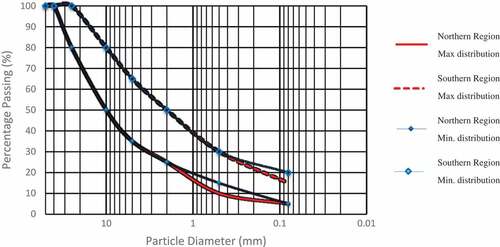
2.2. Chemical stabilization selection
A total of 30 samples using seven different soil-chemical stabilizers combinations were tested, according to current ASTM and Chilean standards (Alarcón, Citation2015; Bozo & Cabezas, Citation2016; Leiva, Citation2015; Vega & Cabezas, Citation2017; Yasima, Gonzalez, & Cabezas, Citation2016). For choosing and planning a laboratory dataset with proper soil-additive combinations for increasing shear strength, commonly used guidelines were adopted (Army, Citation1997). Among the recommended chemical stabilizers are:
Asphaltic: usually applied as bituminous product or emulsion, reducing permeability. It is recommended for granular materials, soils with fine content lower than 20% and PI lower than 10 (Lim, Wijeyesekera, Lim, & Bakar, Citation2014), Lately extended to Bituminous emulsion (D’Angelo, Thom, & Lo Presti, Citation2016; Moaveni, Abuawad, Hasiba, Zhang, & Tutumluer, Citation2012).
Enzymatic: organic blend like proteins, bio-degradable. It works clustering fine particles due to ionic exchange. It requires longer processing time and a small content of organic component within the soil volume. It is recommended for soils with medium plasticity, such as PI between 15 and 20 (Ivanov & Chu, Citation2008; Mousavi & Karamvand, Citation2017; Taha, Khan, Jawad, Firoozi, & Firoozi, Citation2013; Venkarasubramanian & Dhinakaran, Citation2011)
Polymeric: it is feasible to apply in all kind of soils. It also works as clustering soil particles and sealing the soil surface. Shear strength may increase for dry soils several, thus it is especially recommended in practice at dry weather. (Mirzababaei, Arulrajah, & Ouston, Citation2017; Musavi, Abdi, & Estabragh, Citation2014). Generally, these products do not have binding properties; thus, they work preferably in soils with large amounts of clay or silt.
The experimental dataset for all samples for each soil-additive combination, after considering guidelines and literature review, is summarized in Table . It can be seen than gravel concentrates the most quantity of tests because of their practical implication on rural roads, but every soil and every additive had at least one additive-soil combination is analyzed.
Table 2. Dataset for laboratory tests for all studied soil-additive combination cases
Because of the scope in this research, chemical stabilizers not designed for increasing soil shear strength were not considered, including chemical stabilizers for dust suppression is semi-desertic zones like salts. Besides, the shear strength increase by salt additive is not supposed to be reliable. Other additives developed recently such as organic ash were not considered for its incipient use in this type of projects, although have shown potential for its application (Kumar, Gaurav, Kishor, & Suman, Citation2017).
2.3. Soil selection
The analyzed soils were obtained from several locations along Chile, considering some northern locations and mostly southern locations from rainy weather, such as Valdivia, Los Angeles, and Concepcion. Gravel samples were also obtained from locations near to Santiago. All samples were rebuilt from disturbed condition according to Proctor optimal moisture content procedure, as presented previously in Table .
3. Results
Assessed results for all soil-additive studied combinations are presented in Table , for granular and cohesive soils. In all studied cases, results were obtained using its optimal moisture content obtained with a Proctor test. To analyze the results, they were grouped in terms of CBR variation and Unconfined Compressive Strength variation respect from the chemically non-stabilized condition. Then, results were divided to analyze dependency in terms of main soil, chemical stabilizer and some specific property of soils, such as Fines Content, Plasticity Index or Moisture content within the sample.
Table 3. Summary of characterization and laboratory results of soils after the application of the chemical stabilization method, including asphaltic, enzymatic and polymeric additives and its bearing capacity improvement respect of the initial case. The fields without variation means that tests were not conducted in those cases
3.1. Fines content
Tested additives tend to show a bigger increase of shear strength if a small fine content is available at the soil sample, as presented in Figure , that shows the normalized CBR variation in the stabilized cases as a function of the type of soil, type additive, and fines content according to laboratory dataset. Complementarily, Figure shows values before and after the chemical stabilization for CBR tests and Unconfined Compression Strength tests.
Figure 4. Best improvement for each soil-additive case after the chemical stabilization, presented in terms of the Normalized CBR value. Results are grouped in terms of the fine content percentage
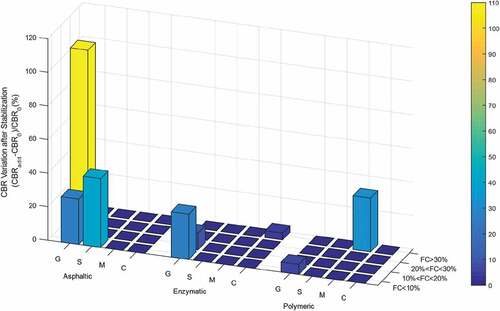
Figure 5. Assessment of Soil Strength variation with CBR and UCS tests in terms of the soil fines content, after the chemical stabilization. At left, samples with asphaltic additive. At center, samples with enzymatic additive. At right, samples with polymeric additive
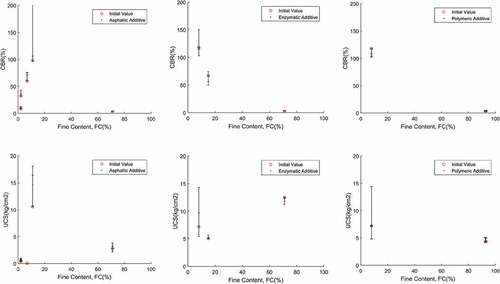
It can be seen that a fine content below 10% shows an increase in bearing capacity for most tested additives, especially as seen for the asphaltic case, which is seen also for fines contents lower than 20%. This shear strength improvement is not clear for polymeric additive, which shows positive and negative strength variations. If fines content is greater than 30%, the chemical stabilization shows low increases of mechanical strength or even decreasing. This effect is seen for all additives, but it is especially important for asphaltic additive, that validates to do not to be proper in this type of soils. At polymeric additive cases, it provides a low positive effect, because of their interaction in terms of the plasticity of the soil sample.
3.2. Plasticity index
Same results but grouped and shown in terms of the plasticity index are presented in Figure , which shows strength variation with respect from the non-stabilized case for a normalized CBR variation. As commented in the previous section, Figure shows the values before and after the chemical stabilization for CBR tests and Unconfined Compression Strength. For low to no plasticity soil samples, which means in practice a small amount of no plastic clay or silt, all additives obtain an increase of shear strength, especially if using an asphaltic additive, which may improve from 30% even up to 100% from its initial value.
Figure 6. Best improvement for each soil-additive case after the chemical stabilization, presented in terms of the Normalized CBR value. Results are grouped in terms of the Plasticity Index
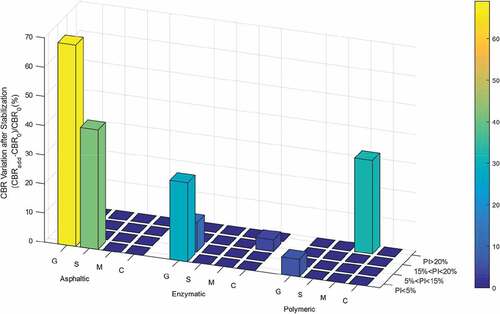
Figure 7. Assessment of Soil Strength variation with CBR and UCS tests in terms of the plasticity index, after the chemical stabilization. At left, samples with asphaltic additive. At center, samples with enzymatic additive. At right, samples with polymeric additive
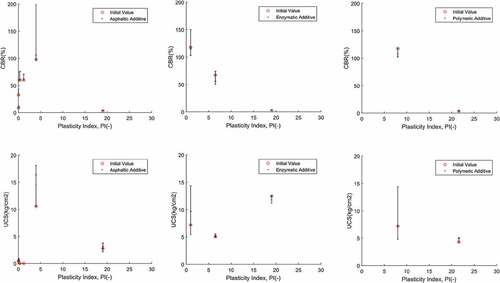
For soils with medium plasticity, it means PI between 5 and 15, it shows a mixed behavior, with some cases increasing its shear strength, but most of them have a decreasing strength effect. The tendency to apply enzymatic additive in these types of soils as recommended by literature review was not clearly evidenced in these tested samples. In another case, it can be noticed that for higher plasticity index in soils, it is increasing strength is not relevant except for polymeric additive, which shows nearly 40% of improvement in relative terms, but still being a low mean value as seen in CBR and UCS tests.
3.3. Moisture content
Finally, results shown in terms of its optimal moisture content are summarized in Figures and , which shows values before and after the chemical stabilization for normalized CBR values and values for CBR and UCS tests, respectively.
Figure 8. Best improvement for each soil-additive case after the chemical stabilization, presented in terms of the Normalized CBR value. Results are grouped in terms of the moisture content percentage
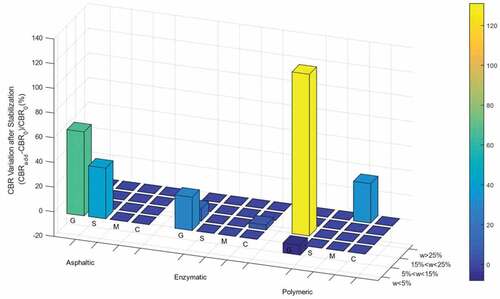
Figure 9. Assessment of Soil Strength variation with CBR and UCS tests in terms of the soil moisture content, after the chemical stabilization. At left, samples with asphaltic additive. At center, samples with enzymatic additive. At right, samples with polymeric additive
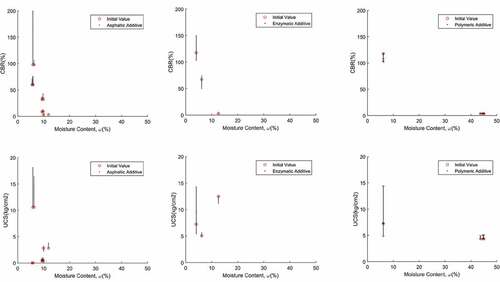
For soils using asphaltic and enzymatic additives, the optimal moisture content is seen for low values, such as 5% to 15%. Also, it can be noticed that better results are obtained near 8%, and moisture greater than 15% shows low increase or even a decreasing effect of shear strength. In another case, for soils with a polymeric additive, it needs an increase in moisture content for significantly increasing, reaching up to 25%. If the moisture content is below 10%, it seems to be not useful for shear strength improvement, nonetheless if moisture content is too high within the sample, the relative effect can be significant, but the absolute value of shear strength improvement is almost neglectable.
These observations may affect how to address the moisture content in practice. In areas with greater contact with the sun, soil gets dry and moisture content is lost. This may lead to an underestimation of the increase in soil strength. On the other hand, more shaded areas can better maintain the concentration of additive during the hardening process. Therefore, it is very important to assess the moisture content and to plan the additive concentration previously.
4. Discussion
4.1. Comparison to literature guidelines
As commented previously, andesite-based soils may have different mechanical behaviors, and a unique chemical stabilizer is not easy to suggest. In order to compare to reviewed literature guidelines (Army, Citation1997), Figure presents a scheme with the cases that reach the best shear strength increase, in terms of the different soils analyzed. A conventional approach suggests two main types of additives in terms of grain-size distribution: asphaltic for soils with fine content lower than 50%, and concrete in another case. Results for these soils shown that grain-size distributions are not the only criteria for choosing an optimal soil-additive combination, but also the PI makes a great influence on the soil strength increasing. Recent developments in additives and applications for andesite soils have provided new alternatives, more specific for different cases. For soils with low fine content and high granular content, enzymatic and polymeric cases are also suitable for this type of soils depending on Fine Content percentage and PI. Then, an optimal combination must take into account both variables at the same time, as detailed next.
Figure 10. Best results by the application of the additive to main soil distribution compared to the proposal of US-Army (US Army, Citation1997), where additive for granular material at left is asphaltic and for cohesive material is concrete
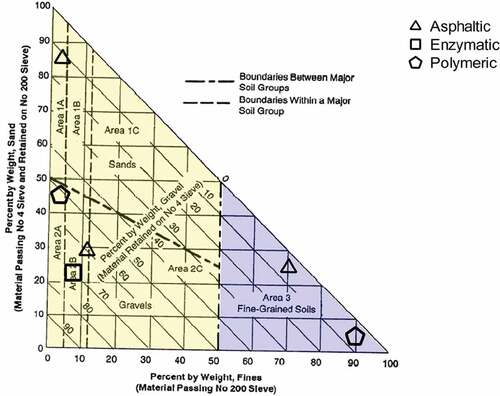
4.2. Effective Additive Concentration (EAC)
Effective Additive Concentration parameter (, EAC), as presented previously in EquationEquation 2
(2)
(2) , is a parameter that searches for an optimal combination of water-additive to the dissolution per unit soil volume. In case of non-optimal strength increases, it may be due to a lack of water content to react with the available additive, or regarding the total water volume inside the soil sample. Results for EAC are shown in Figure , that groups the best shear strength increases and the non-optimal strength variation, for all the mechanical tests in the studied cases. It can be noticed that in asphaltic and polymeric additives shows a tendency for an optimal effective additive concentration, that tends to obtain a best soil-additive interaction behavior. In tests for asphaltic cases, it can be identified between 3.0 and 4.0 (l/m3), while values outside that range have an available strength improvement to develop. In case of the polymeric additive tests, EAC parameter it is about between 0.7 and 2.0 (l/m3), arguing similar water-additive reaction within the stabilized soil sample.
Figure 11. Equivalent moisture content for the studied chemical stabilizers applied to different soils. Filled symbols show all optimal soil strength increase obtained for all test using the stabilizer, while non-filled symbols are non-optimal strength improvements (a) Asphaltic additive (b) Enzymatic additive (c) Polymeric additive

Nonetheless, an optimal EAC parameter cannot be easily identified for enzymatic additive, because of the nature of the reaction. Instead, other parameters like PI or Activity Index seems to make a higher influence in the sample. In this case, in practice is still being more useful to apply some empirical rules, such as enzymatic additive may be suggested if the fine content is lower than 20% and PI is lower than 40. Water content is slightly above of optimal moisture content, because of the tendency of high-water consumption of this additive.
5. Conclusions
Non-pavemented roads may play a major role in connectivity in some temporary or permanent applications, such as mining roads or rural roads. In case of soft soils, chemical stabilization provides a reliable way to improve bearing capacity and decrease maintenance costs, but it depends on the soil characteristics and the applied stabilizer. Although the properties of the soil may change during the construction of a road, having an appropriate technical framework allows to know the expected ranges of soil performance due to an additive, having a better estimation of the required stabilizer and its optimum performance. In this research, a complete experimental study was conducted for several andesite-based soils and chemical stabilizers combinations, in order to obtain relations for soil characteristics such as grain-size distribution, plasticity index or moisture content.
The strengthening effect of chemical stabilizers in soils it is clearer in soil with low fine content. For asphaltic, enzymatic and polymeric stabilizers, an increasing effect is seen, up to 200% of its initial strength value without additives. That effect is not reliable in case of high fine content, which shows positive and some negative cases. A similar effect is noticed in the plasticity index of the fine content, wherein low to no plasticity soils best results were given by asphaltic additives. In the case of moisture content, for cases greater than 15%, an excessive content of water is seen, and only polymeric additive provides a strength increase. For most studied cases, asphaltic stabilizer has proven to increase the bearing capacity under controlled moisture content at the sample, regardless of its fine content or its plasticity index.
For the studied soils, results are slightly different to usually recommendation guidelines for applying chemical stabilization. It was proved that soil strengthening response depends on grain-size distribution, but also on the Plasticity Index. This effect is sensitive for an enzymatic additive case, that may even lead to decrease of its value without the additive.
As moisture content plays a major role in stabilized soil performance, an Effective Additive Concentration (EAC) parameter was defined and studied for all combinations, in order to normalize parameters and identify a unique and overall effect for an entire soil volume. It was noticed that for asphaltic and polymeric cases, it exists an optimal concentration of additive per unit volume of soil, near to 3.5 (l/m3) and 1.0 (l/m3), respectively. Those values optimize the stabilized soil strength capacity improvement. This relation was not clearly suitable for enzymatic cases, but a tendency near to 0.01 (l/m3) may be seen. Future research on this parameter and its application to soil improvement for different engineering projects is recommended, such as piles in deep soils, embankments or dams, which has not been extensively applied, because of the lack of knowledge and reliability compared to other ground improvements techniques.
Acknowledgements
The authors gratefully acknowledge the research agreement of Universidad San Sebastian and VialCorp, alongside with their support and willingness to the study.
Additional information
Funding
Notes on contributors
R. Cabezas
Mr. Cabezas is geotechnical engineer and MSc in geotechnical engineering. Nowadays is finishing a doctorate program in mining engineering, focusing his research in geomechanical behavior of deep underground excavations. Among his interests are mechanical behavior under high-stress conditions and numerical modeling of the cumulative damaging process in soil and rocks, for example in high waste rocks dumps and deep tunneling. Mrs. Cataldo is civil engineer, with over 15 years of experience in soil improvement with chemical stabilization and pavement design and construction.
References
- Afrin, H. (2017). A review on different types of soil stabilization techniques. International Journal of Transportation Engineering and Technology, 3(2), 19–17. doi:10.11648/j.ijtet.20170302.12
- Alarcón, J. (2015). Análisis del Comportamiento Mecánico y Mineralógico de Suelo Procedente del Sector Angachilla ubicado en Valdivia a partir de una Estabilización con Productos Químicos. Escuela de Ingeniería Civil en Obras Civiles. Universidad Austral de Chile, Chile.
- Amin, D. (2015). Triaxial testing of lime/cement stabilized clay. A comparison with unconfined compression tests (Master's Thesis). Division of Soil and Rock Mechanics. KTH Royal Institute of Technology.
- Bozo, N., & Cabezas, R. (2016). Caracterización del Comportamiento Mecánico de Suelos con una Emulsión Asfaltica (Thesis). Escuela de Ingeniería Civil, Universidad San Sebastián, Santiago, Chile.
- D’Angelo, G., Thom, N. H., & Lo Presti, D. (2016). Potential of bituminous emulsion for ballast stabilization. Construction Building Materials, 124, 118-126.
- Ivanov, V., & Chu, J. (2008). Applications of microorganisms to geotechnical engineering for bioclogging and biocementation of soil in-situ. Reviews in Environmental Science and Bio/Technology, 7(2), 139–153. doi:10.1007/s11157-007-9126-3
- Jones, D., Rahin, A., Saadeh, S., & Harvey, J. T. (2010). Guidelines for the stabilization of subgrade soils in California. Pavement Research Center, University of California, CA.
- Kumar, A., Gaurav, K., Kishor, R., & Suman, S. (2017). Stabilization of alluvial soil for subgrade using rice husk ash, sugarcane bagasse ash and cow dung ash for rural roads. International Journal of Pavement Research and Technology, 10, 254–261. doi:10.1016/j.ijprt.2017.02.001
- Leiva, A. (2015). Análisis del comportamiento del Estabilizador VC-Flex en la Estructura de Caminos Secundarios en la Región de Los Ríos. Escuela de Ingeniería Civil en Obras Civiles, Universidad Austral de Chile, Chile.
- Lim, S., Wijeyesekera, D., Lim, A., & Bakar, I. (2014). Critical review of innovative soil road stabilization techniques. International Journal of Engineering and Advanced Technology, 3, 5.
- Mirzababaei, M., Arulrajah, A., & Ouston, M. (2017). Polymers for stabilization of soft clay soils. Procedia Engineering, 189, 25–32. doi:10.1016/j.proeng.2017.05.005
- Moaveni, M., Abuawad, I., Hasiba, K., Zhang, D., & Tutumluer, E. (2012). Characterization of emulsion bitumen stabilized aggregate base. In Proceedings of 2nd International Conference on Transportation Geotechnics. Sapporo, Japan.
- Mousavi, S., & Karamvand, A. (2017). Assessment of strength development in stabilized soil with CBR PLUS and silica sand. Journal of Traffic and Transportation Engineering, 4(4), 412–421.
- Musavi, F., Abdi, E., & Estabragh, A. R. (2014). Assessing the capability of polymer stabilizer in forest road stabilization. Iranian Journal of Forest, 6(1), 1–10.
- Naeini, S. A., & Ziaie, R. (2009). Effect of plasticity index and reinforcement on CBR value of soft clay. International Journal of Civil Engineering, 7(2), 61–69.
- National Academies of Sciences. (2009). Recommended practice for stabilization of subgrade soils and base materials. National cooperative highway research program. Washington, DC: The National Academies Press. doi:10.17226/22999
- NCh2505. (2001). Estabilización química de suelos - Caracterización del produto y evaluación de propiedades de desempeño del suelo. Instituto Nacional de Normalización. Retrieved from http://www.inn.cl
- Obras Publicas, M. D. (2018). Dirección de Vialidad. Retrieved from http://www.vialidad.cl/Paginas/default.aspx
- Parsons, R. L., & Milburn, J. P. (2003). Engineering behavior of stabilized soils. Journal of the Transportation Research Board, 1837, 20–29. doi:10.3141/1837-03
- Peter, T. M., & Little, D. N. (2002). Review of stabilization on clays and expansive soils in pavements and lightly loaded structures history, practice and future. Journal of Materials in Civil Engineering, 14, 447–460. doi:10.1061/(ASCE)0899-1561(2002)14:6(447)
- Sharma, N. K., Swain, S. K., & Sahoo, U. C. (2012). Stabilization of a clayey soil with fly-ash and lime: A micro level investigation. Geotechnical and Geological Engineering, 30(5), 1197–1205. doi:10.1007/s10706-012-9532-3
- Sherwood, P. (1993). Soil stabilization with cement and lime. State of art review. London, UK: Transport Research Laboratory, HMSO.
- Taha, M. R., Khan, T. A., Jawad, I. T., Firoozi, A. A., & Firoozi, A. A. (2013). Recent experimental studies in soil stabilization with bio-enzymes - a review. Electronic Journal of Geotechnical Engineering, 18, 3881–3894.
- Tingle, J. S., & Santori, R. L. (2003). Stabilization of clay soils with nontraditional additives. Journal of the Transportation Research Board. 1819(1), 72-84. doi:10.3141/1819b-10
- US Army. (1997). FM 5-410: Military soils engineering. Washington, DC: Department of the Army.
- Vega, C., & Cabezas, R. (2017). Análisis Experimental de Efectos de Estabilizado Químico en Suelos no Plasticos (Thesis). Escuela de Ingeniería Civil, Universidad San Sebastián, Santiago, Chile.
- Venkarasubramanian, C., & Dhinakaran, G. (2011). Effect of bio-enzymatic soil stabilization on unconfined compressive strength and California bearing ratio. Journal of Engineering and Applied Sciences, 5, 295–298.
- Verdugo, R. (2008). Singularities of geotechnical properties of complex soils in seismic regions. Journal of Geotechnical and Geoenvironmental Engineering, 134, 7. doi:10.1061/(ASCE)1090-0241(2008)134:7(982)
- Vialidad, D. D. (2015). Manual de Carreteras. Santiago, Chile. Retrieved from http://www.vialidad.cl/areasdevialidad/manualdecarreteras/Paginas/default.aspx
- Yasima, N., Gonzalez, F., & Cabezas, R. (2016). Estabilización Química de Suelos con Aditivos Enzimáticos y Polimérico (Thesis). Ecuela de Ingeniería Civil, Universidad San Sebastián, Santiago, Chile.
- Zhao, Y., Gao, Y., Zhang, Y., & Wang, Y. (2016). Effect of fines on the mechanical properties of composite soil stabilizer-stabilized gravel soil. Construction and Building Materials, 126, 701–710. doi:10.1016/j.conbuildmat.2016.09.082
